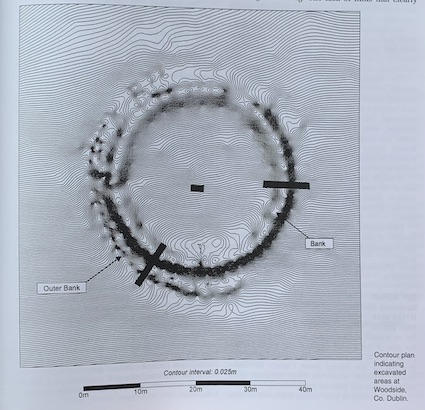County: Dublin Site name: WOODSIDE
Sites and Monuments Record No.: SMR 22:69 Licence number: 98E0074
Author: Martin Reid
Site type: Designed landscape - tree-ring
Period/Dating: Post Medieval (AD 1600-AD 1750)
ITM: E 718238m, N 725088m
Latitude, Longitude (decimal degrees): 53.262949, -6.227672
A site topographic survey of this monument at Woodside, Sandyford, including contour plans and hill-shaded models, was carried out by Barry Masterson and Paul Sinnott of the Discovery Programme. This showed the earthwork to have an internal diameter of 24m and an external diameter of c. 28.5m.
Three test-trenches were excavated in February 1998, two across the bank and ditch and one in the interior of the circle. Trench 1, excavated across the east side of the feature, uncovered a U-shaped ditch (2m wide, 0.5–0.65m deep) and internal bank (0.5–0.7m high). The similarity of proportions indicates that the bank was formed from material upcast from the ditch. A 'Paris Vase' or 18th-/19th-century stoneware base sherd was recovered from the ditch, along with an iron coal shovel, iron horseshoe and nails. Trench 2, a small trench excavated to a depth of 0.25–0.3m in the middle of the ring, consisted of a profile of rooty humic soil over boulder clay. Trench 3 was excavated across the bank and ditch in the south-west. In this area the ditch was 1m wide and only 0.25m deep. The bank was 0.6–0.7m higher than the external ground level here, which is partially accounted for by the prevailing slope. An iron-link chain, a horseshoe and further iron nails were found in this section of the ditch.
The survey illustrates that the earthwork is circular in plan, which is one of the more distinctive criteria for recognition of a tree ring. The lack of any clear entrance gap and the planting of ornamental trees including beech on the ring-bank also point to its being a tree ring. The lack of finds that clearly pre-date the 17th century, when the earliest tree rings were constructed, also points to this category of monument.
Archaeological monitoring of groundworks was recommended; however, the National Monuments Service may require further archaeological investigations before this goes ahead.

37 Errigal Road, Drimnagh, Dublin 12